#3 August 1804
Photo


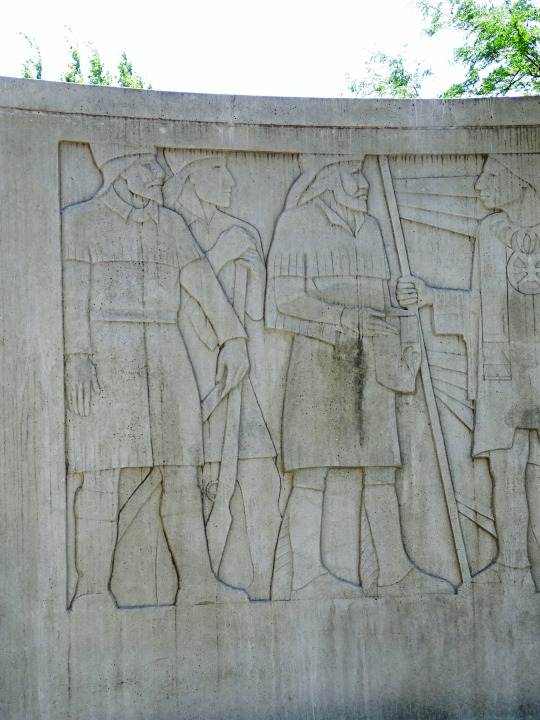


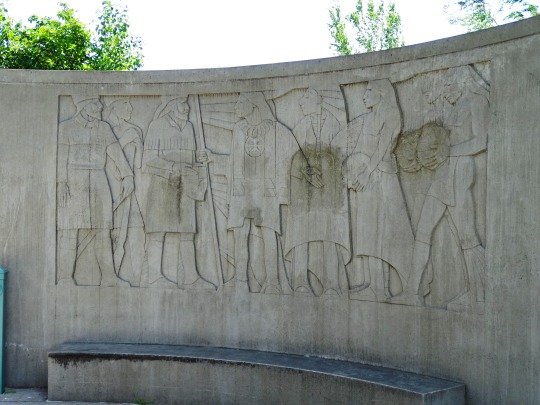
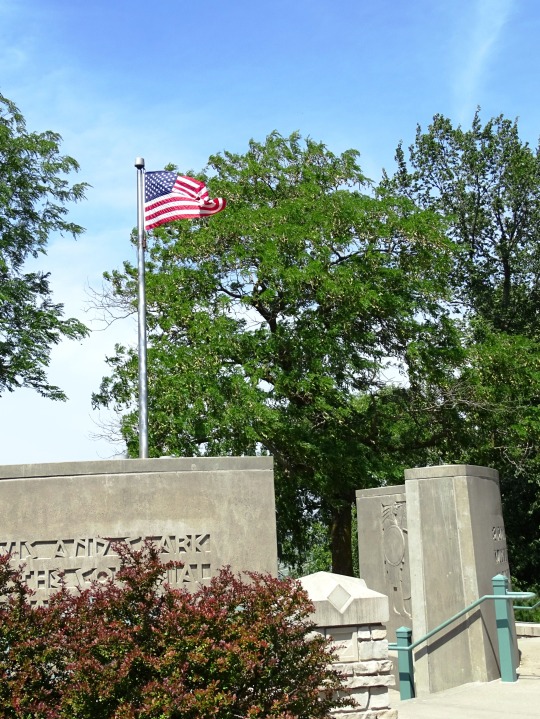
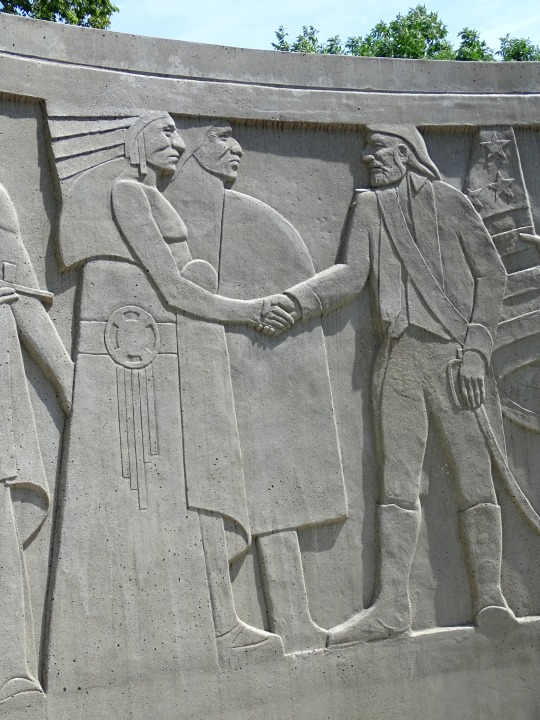


Lewis and Clark met the Otoe and Missouria tribe on August 3, 1804.
#Lewis and Clark Monument Park#Council Bluffs#Iowa#Midwestern USA#travel#Harry Edward Stinson#white colonialism#met#Otoe#Missouria#native american#white col#3 August 1804#anniversary#US history#USA#Nebraska#Missouri River#landscape#cityscape#Omaha#nature#summer 2019#original photography#tourist attraction#landmark#relief
1 note
·
View note
Photo

On this day, 1 January 1804, Haiti became an independent republic, following the revolution which had begun 13 years earlier as a rebellion of enslaved people against slavery and French colonialism. Previously known as Saint-Domingue, it was the most profitable colony in the world, generating greater revenue than all of the continental North American colonies combined. This immense wealth was generated by the sweat and blood of enslaved Africans who were being worked to death in their tens of thousands on coffee and sugar plantations. Shortly after the French revolution, which supposedly espoused the ideals of "liberty, equality and fraternity," on August 22, 1791 enslaved people rose up, demanding those ideals be realised, and slavery and colonialism abolished. Over the coming years, the rebels successfully defeated the combined armies of the world's biggest colonial powers: France, Spain and Britain. The 1804 declaration of independence abolished the colony of Saint-Domingue and reinstated the Indigenous Taíno name of Hayti. Europe and the US then promptly ostracised the fledgling republic, causing severe economic hardship. In 1825, France finally agreed to recognise Haiti's independence, provided it compensate former enslavers to the tune of 150 million gold francs ($21 billion today) - a ransom which deeply impoverished the government and was not fully repaid until 1947. The United States only recognised Haitian independence in 1862, but this did not prevent it from invading and occupying it in 1915. Learn more about this rebellion and others around the world in this book by CLR James: https://shop.workingclasshistory.com/products/a-history-of-pan-african-revolt-c-l-r-james https://www.facebook.com/workingclasshistory/photos/a.1819457841572691/2176487692536369/?type=3
480 notes
·
View notes
Text
Bessières's correspondence
This is for @flowwochair: the index of the documents in the "Fonds Maréchal Bessières" in the French National Archives. Not much about the content, unfortunately. I summarised some points that I imagined were not all that interesting to you. Please let me know if there is something you'd want to have more details on and I will look if there is more.
1) Letters and orders by Napoleon to Bessières, dating from 1796 to 1813. It’s organized by the different armies and contains mostly »official« stuff of some importance, like documents related to the double abdication of the two Spanish Bourbon kings in 1808. Murat’s name is mentioned once, in connection with one document:
copies of Napoleon's instructions to Murat on how to deal with the Spanish, 17 and 28 April 1808
Maybe also of interest: some of the documents concern the reorganisation of the troops after the Russian campaign and date as late as mid and end-April 1813, so only days before his death
2) Letters from princes of the imperial family to Bessières
Mostly interesting because a large chunk seems to be labeled »a.s.«, which I believe to mean »autographe signée«, i.e., handwritten and signed. Most correspondence of important people would have been in the hands of secretaries, with the sender merely signing them. Bessières being worthy of receiving letters that these imperial princes had written themselves hints at a special position of trust.
41 letters from Joseph Bonaparte, related to events in Spain (1808 – 1811)
2 letters (not written by Jerome himself) about uprisings in Kassel in 1813
And here you go: 29 letters by Murat, in his own handwriting, relating to the daily report on the Guard, the policy to be followed, and to military events in Spain (dated 5 August 1805 to 5 June 1808)
Followed by some stuff for me: 22 letters from Eugène de Beauharnais, in his own handwriting and »d’un caractère surtout personnel« (of primarily private nature), dated 27 January 1805 - 5 June 1808
Other than that, there are letters from Josephine, Lebrun, Hortense, Stéphanie de Beauharnais, Méneval and the secretary of Madame Mère.
The rest of this section are documents related to Bessières’s military career, decorations etc.
3) Some personal letters. The connection between them escapes me
from Bessières to his sister-in-law (?), 22 February 1808.
from Bessières to a marshal on the reorganisation of the Guard, 27 January 1813.
from Madame la Maréchale concerning her financial distress, 12 December 1813 and 12 December 1814.
Facsimile of a letter from the Marshal to his wife, after his departure for the 1813 campaign
4) Certificates, letters of service and appointment, decorations
Some documents as early as 1792 among them, but mostly bits and bobs that seem unrelated
5) Letters adressed to Bessières – Army of Italy and Army of Egypt. 55 pieces
6) Ministers' reports to the Emperor and various letters. Plenty of documents and letters among them that are neither written by or adressed at Bessières
7) Imperial Guard I (Organisation, financial reports etc.)
8) Imperial Guard II (contains one more letter by Eugène!)
9) Imperial Guard III (Holland in 1810)
10) Legion of Honour and pay. 73 pieces, 1804 to 1813
11) Russia. Letters adressed to Bessières, situation reports, mostly from before the campaign started
12) Letters from Napoleon, the imperial family, the royal family and several famous personalities. A lot of them obviously from after Bessières’s death, among them (condolation) letters to Madame la Maréchale from
Napoleon - 6 May 1813
Madame Mère – 7 May 1813
Marie Louise – 5 May 1813
Caroline Murat – 25 May 1813
Eugène Beauharnais – 2 June 1813
Joachim Murat – 8 June 1813
Also contains 18 letters from Hortense de Beauharnais to Madame la Maréchale, dated 1809 to 1813, letters from Madame la Maréchale Oudinot, from Laure Junot, from Wellington (handwritten!) and plenty more
And on a happier note: a letter by Joachim Murat dated 1 Germinal year VIII (22 March 1800)
13) Related to Bessières’s city house
14) Correspondence between Marshal Bessières and Madame la Maréchale I
3 letters from Bessières to his wife, 2 prairial-15 vendémiaire an XIV (22 January-7 October 1805)
75 letters of Madame la Maréchale to Bessières, found in the cassette of the marshal after his death, 5 January 1806-1 May 1807
29 letters of Bessières to his wife, 26 March-13 December 1808
15) Correspondence between Marshal Bessières and Madame la Maréchale II. Continuation from above
72 (? I’m not sure about the numbering here) letters from Bessières to his wife, 5 January 1809, 28 September and ... 1811
48 (?) letters from Madame la Maréchale to the Marshal, January-9 December 1811
16) Correspondence between Marshal Bessières and Madame la Maréchale III. Continuation from above
9 letters from the Maréchale Bessières to her husband, 19 March - 16 December 1812
40 letters from Bessières to his wife, 13 January 1812 - 24 April 1813
17) Related to the electoral college of département Haute-Garonne
18) Personal papers, financial documents, real estate etc.
19) Letters to Madame la Maréchale during Restauration and July Monarchy
20) Collection of autographed letters unrelated to Bessières
37 notes
·
View notes
Text
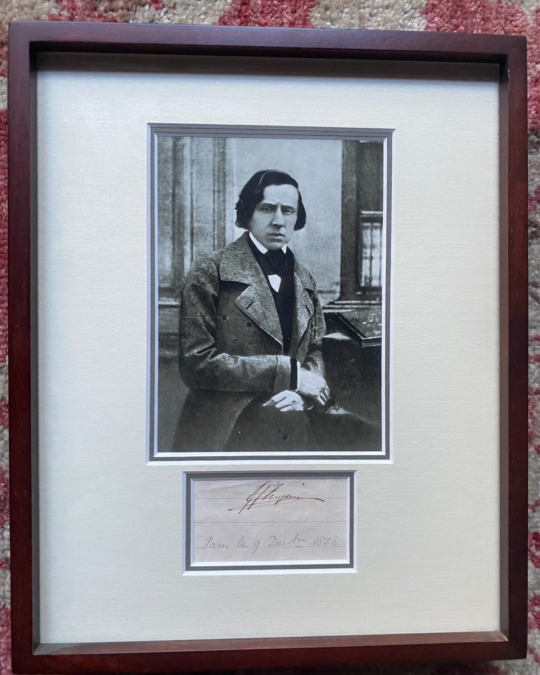


OTD in Music History: Legendary pianist-composer Frederic Chopin (1810 – 1849) makes his last public appearance on a concert platform at the Guildhall in London in 1848. As a patriotic gesture, he plays at a benefit held for Polish refugees; unfortunately, this proves to be both a futile and taxing mistake, since more of the attendees at this event are far more interested in dancing and imbibing refreshments than in listening to Chopin’s artistry, and the exertion leaves him feeling even more drained and weak than he was before. Chopin weighs less than 100 lbs and is already terminally ill from the tuberculosis that will kill him in less than a year…
PICTURED: A beautiful example of Chopin's "classic" full signature, dated in pencil by another contemporaneous hand – probably that of celebrated cellist August Franchomme (1808 – 1884). This example originates directly from the Franchomme estate. Franchomme was the most celebrated French cellist of his time, and he forged close friendships with both Chopin and Felix Mendelssohn (1809 - 1847). In 1833, Chopin and Franchomme collaborated to write a "Grand Duo concertant" for piano and cello, based on themes from Giacomo Meyerbeer's (1791 - 1864) hit 1831 opera, "Robert le diable". Franchomme also rewrote the cello parts for Chopin's "Polonaise Brillante" (Op. 3), and was the dedicatee of Chopin's Cello Sonata (Op. 65).
Based on comparison with other known examples, and taking into account both the date and the lined paper, it seems very likely that this example was cut from a receipt for royalties paid to Chopin by the Pleyel publishing firm for the sale of some of his original compositions. Assuming that the date written beneath this signature is accurate, Chopin had just met his lover Aurore Dupin (better known by her pen name “George Sand”) (1804 - 1876) for the first time at a party a few weeks before his put pen to paper here.
#Frederic Chopin#Frédéric Chopin#Fryderyk Chopin#music history#classical music#composer#Chopin#piano#pianist#sonata#etude#nocturne#polonaise#mazurka#ballade#orchestra#symphony#concerto#music
46 notes
·
View notes
Text
Who is the worst founding father?
Round 4: Benedict Arnold vs Henry Clay?

Benedict Arnold (14 January 1741 [O.S. 3 January 1740] – June 14, 1801) was an American-born military officer who served during the Revolutionary War. He fought with distinction for the American Continental Army and rose to the rank of major general before defecting to the British side of the conflict in 1780. General George Washington had given him his fullest trust and had placed him in command of West Point in New York. Arnold was planning to surrender the fort there to British forces, but the plot was discovered in September 1780, whereupon he fled to the British lines. In the later part of the conflict, Arnold was commissioned as a brigadier general in the British Army, and placed in command of the American Legion. He led the British army in battle against the soldiers whom he had once commanded, after which his name became, and has remained, synonymous with treason and betrayal in the United States.
Historians have identified many possible factors contributing to Arnold’s treason, while some debate their relative importance. According to W. D. Wetherell, he was:
[A]mong the hardest human beings to understand in American history. Did he become a traitor because of all the injustice he suffered, real and imagined, at the hands of the Continental Congress and his jealous fellow generals? Because of the constant agony of two battlefield wounds in an already gout-ridden leg? From psychological wounds received in his Connecticut childhood when his alcoholic father squandered the family’s fortunes? Or was it a kind of extreme midlife crisis, swerving from radical political beliefs to reactionary ones, a change accelerated by his marriage to the very young, very pretty, very Tory Peggy Shippen?
---
Henry Clay Sr. (April 12, 1777 – June 29, 1852) was an American attorney and statesman who represented Kentucky in both the U.S. Senate and House of Representatives. He was the seventh House speaker as well as the ninth secretary of state. He unsuccessfully ran for president in the 1824, 1832, and 1844 elections. He helped found both the National Republican Party and the Whig Party. For his role in defusing sectional crises, he earned the appellation of the “Great Compromiser” and was part of the “Great Triumvirate” of Congressmen, alongside fellow Whig Daniel Webster and John C. Calhoun.
[Clay and his family] initially lived in Lexington, but in 1804 they began building a plantation outside of Lexington known as Ashland. The Ashland estate eventually encompassed over 500 acres (200 ha), with numerous outbuildings such as a smokehouse, a greenhouse, and several barns. Enslaved there were 122 during Clay’s lifetime with about 50 needed for farming and the household.
In early 1819, a dispute erupted over the proposed statehood of Missouri after New York Congressman James Tallmadge introduced a legislative amendment that would provide for the gradual emancipation of Missouri’s slaves. Though Clay had previously called for gradual emancipation in Kentucky, he sided with the Southerners in voting down Tallmadge’s amendment. Clay instead supported Senator Jesse B. Thomas’s compromise proposal in which Missouri would be admitted as a slave state, Maine would be admitted as a free state, and slavery would be forbidden in the territories north of 36° 30’ parallel. Clay helped assemble a coalition that passed the Missouri Compromise, as Thomas’s proposal became known. Further controversy ensued when Missouri’s constitution banned free blacks from entering the state, but Clay was able to engineer another compromise that allowed Missouri to join as a state in August 1821.
#founding father bracket#worst founding father#founding fathers#amrev#brackets#polls#benedict arnold#henry clay
6 notes
·
View notes
Text
Elizabeth Hamilton to Philip Schuyler, [November 6, 1804]

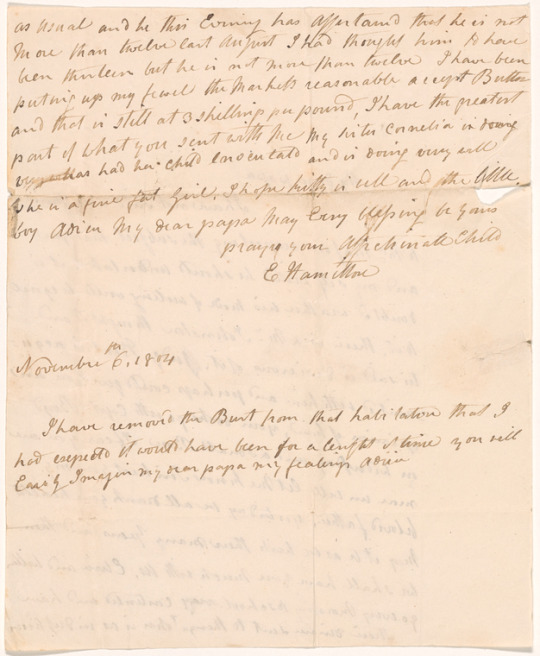
My dear papa
I have not said any thing to Mr. Mason respecting the subject that you and myself wished he should undertake. It is doubted weather his mode of writing would be equal to it. There is a Mr. Johnston thought of and is said is desirous of it. Judge Kent is acquainted with him and perhaps could give you an opinion of him. Your books go with Capt. Boyd on Wednesday and a small Box. I fear you are more unwell. Let me know. I intend you my beloved father, yesterday we all thank your health. May it be as we wish, there many years and then we shall have you much with us. Eliza and William go every morning to school, very contented and have their dinner sent to them. John is as industrious as usual and this Evening has ascertained that he is not more than twelve last August. I had thought him to have been thirteen but he is not more than twelve. I have been putting up my fence. The markets reasonable except Butter and that is still at 3 shillings per pound. I have the greatest part of what you sent with me. My sister Cornelia had her child inoculated and is doing very well. She is a fine fat girl. I hope Kitty is well and the little boy. Adieu My dear Papa. May Every blessing be yours
Prays your affectionate Child
E. Hamilton
November 6, 1804
I have removed the Bust from that habituation that I had expected it would have been for a length of time. You will easily Imagine my dear papa my feelings. Adieu.
#elizabeth hamilton#elizabeth schuyler#philip schuyler#hamilton correspondence#schuyler correspondence#1804
5 notes
·
View notes
Text
Sewing a Regency Gown Part 5 - Photos and Inspiration
October 8, 2020
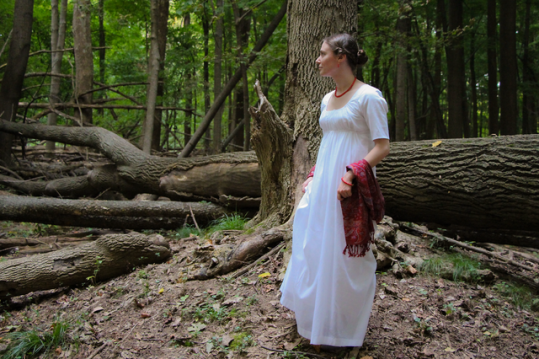
[Image ID: a photo of Alex wearing a white drawstring-front Regency gown with red accessories in the woods.]
Part 1 - Drafting the Bodice
Part 2 - Sewing the Bodice
Part 3 - The Skirt
Part 4 - The Sleeves
I've been thinking about, researching, planning, and preparing for this project for about six years. I was in high school then, and now I've graduated from college. I'm incredibly happy about how it turned out, so I wanted to share some photos! (This post is, for that reason, very photo heavy.)
It's not perfect, of course - bodice lining peaks out of the neckline a bit and there's still something wonky with the sleeves - but it's done. I had an art professor who liked to remind us that "done is better than perfect." I'd rather have a complete imperfect project than a perfect ufo.
Now that my white neo-classical Regency dress is done I wanted to share some of my inspiration! I've got a lot of white dresses saved on this Pinterest board, but I wanted to highlight a few.
This 1798 fashion plate from Costume Parisien. While the waistline is hidden by her shawl, it seems to be gathered at the waist and neckline. A line across the bust might imply the lining layer of the dress or the top edge of her stays.
This 1804 drawing by Jean Auguste Dominique Ingres of Henrietta Harvey and her half-sister Elizabeth Norton. Both women are wearing gowns that seem to have drawstrings in the waist- and necklines. I think I can see the ties of the waistline drawstring on the woman on the left.
Desoria's 1797 portrait of Constance Pipelet shows a classic late-1790s gown, with a high waistline and rounded bust. If you zoom in on the image, you can tell that the waistline is gathered into a tape or piece of fabric, but isn't a drawstring.
You can't see the front of the gown in this undated (but clearly early 1800s) portrait, but I loved how the skirt is ungathered along the sides and densely gathered or pleated into the bottom of the center back bodice panel. I opted to do something similar on my dress.
This extant gown from the National Museum of Norway's digital collection also features a skirt that is ungathered at the sides but densely gathered/pleated under the center back panel. The front bodice of the dress is gathered and seems to have a drawstring at the neckline, but the skirt is only gathered a few inches at the center front. If you zoom in on the bodice you can see the inner lining of the bodice.
And with that, one of my long-term dream projects is done! I know I keep saying this, but I am so excited with how it turned out! I'm already dreaming of the open robes, over bodices, spencers, and matching reticules I can make now...
Stay warm. Stay safe. Stay healthy.

[Image ID: a 3/4 view of Alex from the hips up wearing a white Regency dress with red accessories.]
1 note
·
View note
Text
History
July 4, 1776 - The Declaration of Independence was approved by the Continental Congress.
July 4, 1863- Vicksburg, the last Confederate stronghold on the Mississippi River, surrendered to General Grant and the Army of the West after a six week siege. With the Union in control of the Mississippi, the Confederacy was effectively split in two, cut off from its western allies.
July 4, 1882 - The "Last Great Buffalo Hunt" began on Indian reservation lands near Hettinger, North Dakota as 2,000 Teton Sioux Indians in full hunting regalia killed about 5,000 buffalo. By this time, most of the estimated 60-75 million buffalo in America had been killed by white hunters who usually took the hides and left the meat to rot. By 1883, the last of the free-ranging buffalo were gone.
Birthday - Novelist and short-story writer Nathaniel Hawthorne (1804-1864) was born in Salem, Massachusetts. His works included; The Scarlet Letter, The House of the Seven Gables and The Blithedale Romance.
Birthday - Song writer Stephen Foster (1826-1864) was born in Lawrenceville, Pennsylvania. Among his nearly 200 songs were; Oh! Susanna, Camptown Races, Swanee River, Jeanie with the Light Brown Hair, and Beautiful Dreamer. He died in poverty at Bellevue Hospital in New York.
Birthday - Calvin Coolidge (1872-1933) the 30th U.S. President was born in Plymouth, Vermont. He became President on August 3, 1923, after the death of Warren G. Harding. In 1924, Coolidge was elected President but did not run for re-election in 1928.
0 notes
Text
"A man of wealth": Samuel Packard, the Rhode Island slaver [part 3]
[21] "Slavery, the Slave Trade, and Brown University" within Report of the Brown University Steering Committee on Slavery and Justice, 2006, updated in 2020, accessed July 14, 2021; "Brown, John to Brown, Moses: November 17, 1797," Brown University Library, Brown Digital Repository, accessed July 14, 2021.
[22] "Rhode Island Marriages, 1724-1916", database, FamilySearch, 22 January 2020, Samuel Packard, 1789, p 345, image 569 of 690, within the section entitled "St. Paul's Church--Marriages,"; of Vital record of Rhode Island, 1636-1850, Vol 10, p. 345 within the section “St. Paul’s Church marriages”; M.R.N., "James Earl (1761 – 1796)," AMERICAN GALLERY – 18th Century, Aug. 12, 2014, accessed July 12, 2021; "James Earl: Portrait of Abigail Congdon Packard, ca. 1795," RISD Museum, accessed July 12, 2021; Korr, Mary. "Dr. Throop exemplifies new RISD Museum show: Making It in America," Rhode Island Medical Journal, Nov. 2013, p. 76; "United States Census, 1800," database with images, FamilySearch, accessed 15 July 2021), Samuel Packard, Providence, Providence, Rhode Island, United States; citing p. 197, NARA microfilm publication M32, (Washington D.C.: National Archives and Records Administration, n.d.), roll 45; FHL microfilm 218,680; "United States Census, 1790," database with images, FamilySearch, accessed 15 July 2021), Samuel Packard, Providence, Providence, Rhode Island, United States; citing p. 187, NARA microfilm publication M637, (Washington D.C.: National Archives and Records Administration, n.d.), roll 10; FHL microfilm 568,150.
[23] "Clipped From Weekly Raleigh Register," Weekly Raleigh Register, Raleigh, North Carolina, 30 Apr 1804, Page 3; "Fraud on Underwriters," The Evening Post, New York, New York, 13 Apr 1804, p. 3; Jones, George Farquar, Family Record of the Jones Family of Milford, Massachusetts, and Providence, Rhode Island: With Its Connections and Descendants, Together with the Ancestry and Family of Lorania Carrington Jones, Wife of George F. Jones (George Farquar Jones: Philadelphia, 1884), 43; John Marshall Varnum, A Sketch of the Life and Public Services of Joseph Bradley Varnum of Massachusetts (US: David Clapp & Son, 1906), 19; "A Voyage from Providence to Alexandria, VA. in 1788," Book Notes, Vol. 5, no. 17, Aug. 18, 1888, 117. Also, in 1785, some "dogs were accompanied from France to New York by young John Quincy Adams and were shipped from New York to Mount Vernon in Capt. S. Packard’s sloop Dove," according to letters in August (also see here) and September 1785.
[24] P and S sections of "Owners and Occupants of the Lots, Houses and Shops in the Town of Providence Rhode Island in 1798," RIGenWeb Project, accessed July 14, 2021, transcribed by Henry R. Chace's book of the same name. Also see this comparison of residents in 1759 and 1798.
[25] The Protocol to Prevent, Suppress and Punish Trafficking in Persons, Especially Women and Children, supplementing the United Nations Convention against Transnational Organized Crime, otherwise known as the Trafficking Protocol defines human trafficking, speciically in article 3(a). I'm not the first person to note this, as Karen Bravo in Open Democracy compared transatlantic slavery and contemporary human trafficking, as has Stevie J. Swanson in the Florida A & M University Law Review, UN Office on Drugs & Crime, UN Secretary General in 2008.
Some, however, have rejected the comparison between the two, saying they are distinct, as has Emily Smith, Curator of Contemporary Forms of Slavery, International Slavery Museum, writing about this comparison.
[26] "Accessions and Gifts: June 15, 1923 to March 14, 1924," Bulletin of the Rhode Island School of Design, Vol. XII, April 1924, p. 19; Robert Grandchamp, Jane Lancaster, and Cynthia Ferguson, "Original Members of PMCA" within "Rhody Redlegs": A History of the Providence Marine Corps of Artillery and the 103d Field Artillery, Rhode Island Army National Guard, 1801-2010 (US: McFarland, 2011), 214.
[27] White Jr., "A Rhode Islander Goes West to Indiana (1817-1818)," 22-23; Cole, J. R. History of Washington and Kent Counties, Rhode Island (New York: W.W.Preston & Co., 1889), 392-393.
[28] Ancestry.com; Rhode Island, Wills and Probate Records, 1582-1932; Probate and Town Council Records, Vol 9-13, 1756-1795; image 231, transcribed by Ben Costantino of the Rhode Island Manumissions Project. Also listed is Frances Congdon who had a Black girl "named Desire" and two older Black people, Tenny and Tom.
[29] "Part 1 of Packard's statement" within The Washingtonian, Windsor, Vermont, 07 Oct 1811, page 3; "Part 2 of Packard's statement" within The Washingtonian, Windsor, Vermont, 07 Oct 1811, page 3.
[30] "United States Census, 1810," database with images, FamilySearch, accessed 15 July 2021), Samuel Packard, West District, Providence, Rhode Island, United States; citing p. 69, NARA microfilm publication M252 (Washington D.C.: National Archives and Records Administration, n.d.), roll 58; FHL microfilm 281,232.
[31] Vital record of Rhode Island, 1636-1850, Vol 10, page 382.
[32] "An Act to Prevent the Slave Trade and the Encourage the Abolition of Slavery," October 31, 1787, pages 6-7 of 8, via Rhode Island State Archives Digital Archive page "Quaker petition for abolition of slave trade, June 1787." The fine for violating the law is 100 pounds (and he violated it four times), while the fee for violating Slave Trade Act of 1794 was $2,000. The conversion of Rhode Island pounds to dollars was one pound to one dollar, according to information compiled here.
[33] Fikes also notes that "family history shapes who we and where we come from and what we have access to, today." She also criticizes White historians for sitting on information and only releasing it when they are comfortable to do so.
#rhode island#packards#genealogy#genealogy research#slave trade#slavery#enslaved people#black history matters#black lives matter#brown university#ancestry#lineage
0 notes
Photo









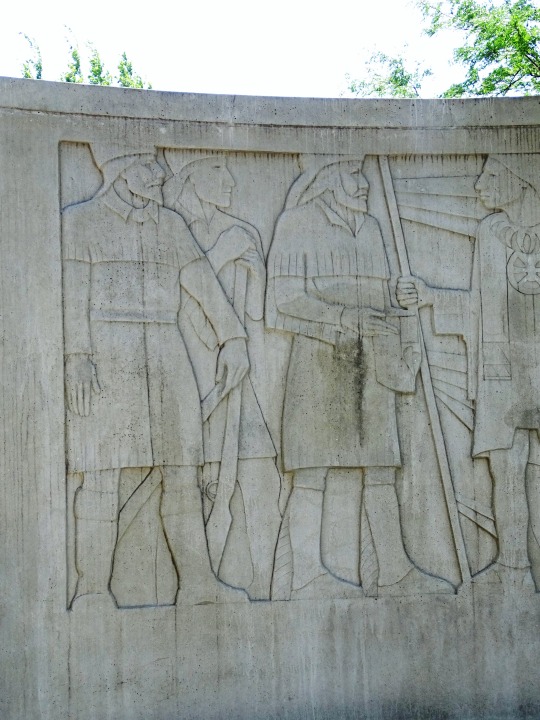
Lewis and Clark met the Otoe and Missouria tribe on August 3, 1804.
#Lewis and Clark#met#Otoe#Missouria#native american#white colonialism#3 August 1804#anniversary#US history#Lewis and Clark Monument#Iowa#Nebraska#Lewis and Clark Park#Council Bluffs#Missouri River#public art#Harry Edward Stinson#Art Deco#vista point#relief#landscape#vacation#Lewis and Clark Monument Park#US flag#tourist attraction#landmark#original photography
1 note
·
View note
Text
Berkův statek v Mezilečí
Původně zde stával dřevěný statek, z jehož číslování můžeme usoudit, že náležel mezi první, které byly ve vsi postaveny. Tilschovský grunt je totiž připomínán již v roce 1729, kdy se Josef Karel Tilsch měl stát sedlákem v čp. 12. Před ním náležel statek roku 1588 Matěji Kadaníkovi, v roce 1619 Martinu Vávrovi, roku 1655 Janu Vávrovi, v roce 1713 Václavu Antošovi, roku 1722 Janu Mertlíkovi. Ohledně vlastnictví čp. 12 rodem Tilschů však vyvstává rozpor, neboť ještě v letech 1793-1798 byl zmíněn jako zdejší sedlák Václav Kadaník, který se 5. října 1791 oženil s Rozálií, ro. Hůlkovou. V roce 1804 zde hospodařil Václav Tilsch, který se oženil s Alžbětou, roz. Antošovou z čp. 24. Právě oba zmínění a jejich následovníci, zejména syn Josef Tilsch, se pustili do přestavby dosavadního statku, což můžeme potvrdit tím, že v indikační skice stabilního katastru z roku 1840 (viz https://ags.cuzk.cz/archiv/openmap.html?typ=skicic&idrastru=HRA294018400) jsou všechny budovy zaznamenány již o dnešní půdorysné podobě, což znamená že k jejich výstavbě došlo právě před tímto rokem.
Po výstavbě čp. 5, zvětšené kopie starého domu, k níž došlo roku 1858 byl dům odlišen pojmenováním „U Hořejších“, zatímco novostavbě se říkalo „U Dolejších“. Určitou dobu bylo hospodářství pronajímáno, např. po roce 1845 zde byl nájemníkem Augustýn Lesk, ale podruhů, čeledínů a děveček se zde vystřídalo několik desítek. Po úmrtí Josefa Vojtěcha Tilsche zdědil nemovitost jeho syn Vilém, jenž se 20. listopadu 1878 oženil s Augustou Tylšovou, dcerou Václava Tylše (Tilsche) z čp. 5. Naopak jeho sestra Viléma se 31. května 1871 vdala za Jana Hoffmanna, knihvedoucího v jedné z budyšínských továren, jenž pocházel z Nového Dvora čp. 3. Netrvalo však dlouho a Vilém Tilsch musel dům prodat v nucené dražbě. V té byl poprvé nabízen v roce 1887, kdy byl spolu s pozemky odhadnut na 51 801 zl. Tehdy ho koupil Josef Firbas z Provodova, ale ten si vše nakonec rozmyslel, a tak bylo celé hospodářství opětovně draženo.
O 2 roky později byl nabízen jen za 47 792 zl. a jeho majitelem se stal Jaroslav Berka z Bakova, který následně větší část pozemků rozprodal. Část z těchto informací nalezneme v obecní kronice, kde je zapsáno následující:
"Čp. 12.
Vilém Tylš obchodník, po zemřelém majiteli koupil usedlost Firbas z Provodova od p. Firbase ji koupil Jaroslav Berka rodák z Bakova, který živnost rozprodal. Nýni jest u domu asi 12 korcu pozemku. Maji s manželkou syna Jaroslava který absolvoval tkalcovskou školu dvouletou v Náchodě, jest zaměstnán u svého strýce Berky na Bakově obchodníka textilním zbožím a majitelem velkého polního hospodářství. Odsloužil si dvouletou vojenskou povinnost jako desátník u jízdy. A dceru Martu. Jaroslav Berka roku rozprodal 17 korcu lesa Adolfu Postupovi čp. 21. Václavu Kejzlarovi 3 korce lesa. Frant. Tučkovi v Křížanově les, pole, rybnik 25 korcu. Syrovátka Josef z Prorube 6 korcu. Astr Jan z Prorube 4 korce. Jakoubek Bedřich čp. 32. 4 korce. Hofman Josef čp. 33. 4 korce Hanuš Adolf čp. 34. 6 korcu. Pokorná Viléma čp. 61. 2 korce totovše bylo odprodáno jako pole. Celba Josef v Posadově má od Berkovi usedlosti 4 a 1/2 korce louky a Boruvka Vilém čp. 75. řezník 1/2 korce louky."
4. července 1929 byl objekt poškozen větrnou smrští. Nejhůře však dopadl stříbrný topol pod čp. 12, který se rozlomil. Opravy střechy a dalších drobných závad proběhly ještě v témže roce. o 10 let později byly hořičským stavitelem Josefem Jiránkem předělány chlévy na mechanickou tkalcovnu. Kvůli nedostatku materiálu se stavba prodlužovala, ale 7. července 1939 se začalo v tkalcovně pracovat. Obdobně dopadly i další následné válečné úpravy areálu. 17. ledna 1940 zemřela vdova Albertina Berková a její pohřeb o 2 dny později byl ztížen velkou sněhovou vánicí, díky níž byl veškerý automobilový a autobusový provoz zastaven, a tak musel pomoci koňský potah s lehkými sáněmi. Ke konci války se zvětšoval nedostatek materiálu a nastaly též obtíže ohledně odbytu. Vše se vyřešilo až po osbobození, kdy byla v letech 1947-1948 tkalcovna ještě rozšířena. Vzhledem k nařízení k zastavení stavebních prací však zůstala novostavba zvenku neomítnuta.
Mnohem větší problémy však přišly po příchodu komunistů k moci. 5. dubna 1951 byla provedena domovní prohlídka u Jaroslava Berky a jeho sestry Marty, během níž bylo nalezeno mnoho ukrytých textilií, potravin, obuvi a jiných věcí. Rozsudek nad nimi byl exemplární, Jaroslav Berka byl odsouzen na 9 let odnětí svobody, ke ztrátě čestných práv občanských na 10 let a k peněžitému trestu 50 000 Kčs. Podobně na tom byla jeho sestra, kterou odsoudili k 6 letům odnětí svobody, ke ztrátě čestných práv občanských na 5 let a k peněžitému trestu 25 000 Kčs. Zároveň došlo k propadnutí jejich veškerého jmění ve prospěch státu. 12. června téhož roku byl navíc do Mezilečí přestěhován Karel Berka s manželkou z Bakova, kde se stal nežádoucí osobou. Více o tomto případu se dá nalézt v knize Věry Vlčkové "Horizonty (ne)svobody: političtí vězni okresu Náchod v letech 1948-1989" z roku 2000.
Následně byla v budově zřízena prodejna smíšeného zboží, která byla uvedena do provozu 1. prosince 1955 a její první vedoucí se stala Anna Tučková z Křížanova. 30. září téhož roku byl propuštěn na svobodu Jaroslav Berka, ale k jeho rehabilitaci došlo až v roce 1991. V únoru 1961 byla v čp. 12 zajištěna místnost pro činnost ČSM. Do roku 1967 působila v čp. 12 rovněž provozovna úpického podniku Texlen 22, v níž se šily a obrubovaly textilie. Po odstěhování strojů a veškerého zařízení koupilo provoz JZD a po dohodě s tkalcovnou v České Skalici zde zavedlo opravnu tkalcovských cívek. Část areálu zase sloužila ke skladování. Prodejna zde narozdíl od opravny vydržela s různými přestávkami až do roku 2007, přičemž dnes náleží čp. 12 Pavle Hoffmanové z Posadova a zbytek areálu vlastní Jaroslav Berka z Hořiček.

Mezilečí čp. 12

Mezilečí čp. 12

Mezilečí čp. 12
0 notes
Text

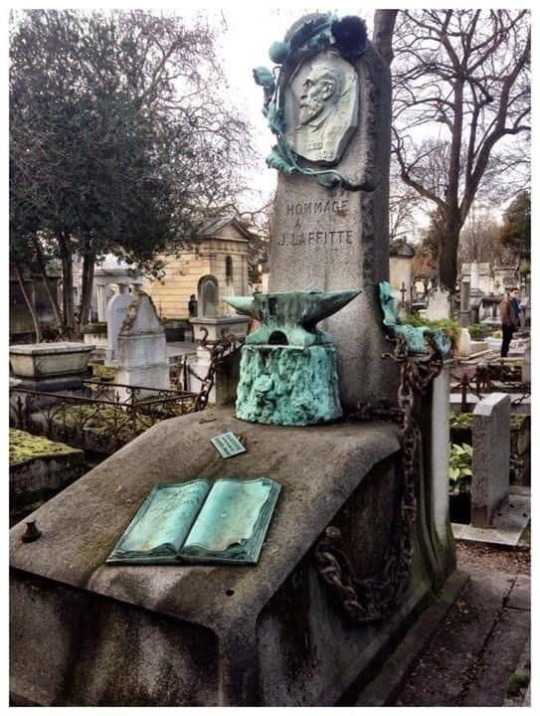



O túmulo de Nureyev,
a manta é feita de mosaicos muito pequenos de cores variadas simulando um Kilin. Peré -
Lachaise - o Cemitério mais famoso e visitado do Mundo.
Com suas mais de 70 mil tumbas em uma área de 44 hectares ( uns 50 campos de futebol) divididas em 93 áreas, o Peré- Lachaise é o mais ilustre Cimitério da capital francesa e também o mais visitado do mundo, recebendo cerca de 3 milhões de visitantes anualmente.
Sendo então um dos lugares mais visitados de Paris, depois da Torre Eiffel, do Louvre, e de Notre Dame, o Cemitério do Peré - Lachaise é um enorme panteão onde se encontram vários personagens da história da França e do Mundo.
Sua origem remonta do século XII, quando o terreno repletos de vinhas pertencentes à igreja.
Em 1430 um comerciante adquiriu as terras e construir uma grande residência, até que a propriedade passou para as mães dos Jesuítas, no século XVII , entre os quais o sacerdote católico François d' Aix La Chaise.
Em 1804, após a expulsão dos Jesuítas, o terreno passou para as mãos da cidade, graças a Napoleão Bonaparte, e assim foi construído o cemiterio, inspirado no estilo dos jardins ingleses.
Inicialmente os parisienses ilustres não estavam muito entusiasmado com a ideia de serem enterrados fora da cidade e num bairro pobre.
Em 1917 mudam-se para o cemitério os restos mortais dos famosos amantes Pierre Abélard e Heloïse d' Argeteuil, tal como de Molière e La Fontaine, e começa a alterar se a percepção inicial que se tinha do espaço.
O cemitério recebeu esse nome em homenagem ao sacerdote e confessor de Luiz XIV , François d' Aix, Senhor de La Chaise - Le Pére La Chaise ( Padre La Chaise), antigo administrador do terreno.
Atualmente o cemitério faz parte de Paris , situando-se a leste no 20° Arrondissement e tem também a maior área verde da cidade.
Alguns nomes de celebridades que tem suas restos mortais guardados no local.
No campo da Literatura e teatro: Molière( 1673) , Proust (1922), Oscar Wilde( 1900) Balzac ( 1850) La Fontaine ( 1695).
No campo da música: Chopin ( 1849), Jim Morrison ( 1971) Edith Piaf ( 1963).
No campo da pintura: Eugéne Delacroix ( 1863) Camille Pisaaro ( 1903).
No campo da filosofia e religião:
Allan Kardec ( 1869) e Auguste Comte ( 1857).
Algums imagens desse lugar tão cheio de memórias e história.
(Segredos de Paris)
0 notes
Text
Who is the worst founding father?
Round 3: Henry Clay vs Josiah Bartlett
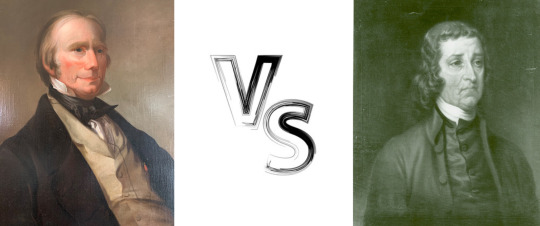
Henry Clay Sr. (April 12, 1777 – June 29, 1852) was an American attorney and statesman who represented Kentucky in both the U.S. Senate and House of Representatives. He was the seventh House speaker as well as the ninth secretary of state. He unsuccessfully ran for president in the 1824, 1832, and 1844 elections. He helped found both the National Republican Party and the Whig Party. For his role in defusing sectional crises, he earned the appellation of the “Great Compromiser” and was part of the “Great Triumvirate” of Congressmen, alongside fellow Whig Daniel Webster and John C. Calhoun.
[Clay and his family] initially lived in Lexington, but in 1804 they began building a plantation outside of Lexington known as Ashland. The Ashland estate eventually encompassed over 500 acres (200 ha), with numerous outbuildings such as a smokehouse, a greenhouse, and several barns. Enslaved there were 122 during Clay’s lifetime with about 50 needed for farming and the household.
In early 1819, a dispute erupted over the proposed statehood of Missouri after New York Congressman James Tallmadge introduced a legislative amendment that would provide for the gradual emancipation of Missouri’s slaves. Though Clay had previously called for gradual emancipation in Kentucky, he sided with the Southerners in voting down Tallmadge’s amendment. Clay instead supported Senator Jesse B. Thomas’s compromise proposal in which Missouri would be admitted as a slave state, Maine would be admitted as a free state, and slavery would be forbidden in the territories north of 36° 30’ parallel. Clay helped assemble a coalition that passed the Missouri Compromise, as Thomas’s proposal became known. Further controversy ensued when Missouri’s constitution banned free blacks from entering the state, but Clay was able to engineer another compromise that allowed Missouri to join as a state in August 1821.
Josiah Bartlett (December 2, 1729 [O.S. November 21, 1729] – May 19, 1795) was an American Founding Father, physician, statesman, a delegate to the Continental Congress for New Hampshire, and a signatory to the Declaration of Independence and Articles of Confederation. He served as the first governor of New Hampshire and chief justice of the New Hampshire Superior Court of Judicature.
On January 15, 1754, he married Mary Bartlett of Newton, New Hampshire. She was his cousin, the daughter of his uncle, Joseph.
The Bartlett family seems to have owned several slaves, and there are references to tracking down runaway slaves in Bartlett’s correspondence.
#founding father bracket#worst founding father#founding fathers#amrev#brackets#polls#henry clay#josiah bartlett
3 notes
·
View notes
Photo

On this day, 1 January 1804, Haiti became an independent republic, following the revolution which had begun 13 years earlier as a rebellion of enslaved people against slavery and French colonialism. Previously known as Saint-Domingue, it was the most profitable colony in the world, generating greater revenue than all of the continental North American colonies combined. This immense wealth was generated by the sweat and blood of enslaved Africans who were being worked to death in their tens of thousands on coffee and sugar plantations. Shortly after the French revolution, which supposedly espoused the ideals of "liberty, equality and fraternity," on August 22, 1791 enslaved people rose up, demanding those ideals be realised, and slavery and colonialism abolished. Over the coming years, the rebels successfully defeated the combined armies of the world's biggest colonial powers: France, Spain and Britain. The 1804 declaration of independence abolished the colony of Saint-Domingue and reinstated the Indigenous Taino name of Hayti. Europe and the US then promptly ostracised the fledgling republic, causing severe economic hardship. In 1825, France finally agreed to recognise Haiti's independence, provided it compensate former slaveowners to the tune of 150 million gold francs ($21 billion today) - a ransom which deeply impoverished the government and was not fully repaid until 1947. The United States only recognised Haitian independence in 1862, but this did not prevent it from invading and occupying it in 1915. Learn more about this rebellion and others around the world in this book by CLR James: https://shop.workingclasshistory.com/products/a-history-of-pan-african-revolt-c-l-r-james https://www.facebook.com/workingclasshistory/photos/a.296224173896073/1889267087925099/?type=3
850 notes
·
View notes
Text
LoSlavery Is Not OUR "Original Sin" The thick lines show majority of African slaves went to Spain’s (they started trans-Atlantic slave trade) Latin American & Caribbean slave colonies, Muslim and African Countries. Few went to colony that became the US

How many times have you heard that slavery was “America’s original sin”? I’m not quite sure what that means, but I think the idea is that slavery was a uniquely horrible thing that defines the United States and will stain whites forever. It’s one of the few things Senate Minority Leader Mitch McConnell and Barack Obama agree on. There are books about it. Here’s a college course at UC Davis called “Slavery: America’s Original Sin: Part 1."
The fact is, there has been slavery in every period of history, and just about everywhere. The Greeks and Romans had it, the ancient Egyptians had it, it’s all over the Bible, the Chinese and the pre-Columbian Indians had it, the Maoris in New Zealand had it, and the Muslims had it in spades. But I have never, ever heard of slavery being anyone else’s “original sin.”
About the only societies that never had slaves were primitivehunter-gatherers. As soon as people have some kind of formal social organization, they start taking slaves.
You’ve heard about slavery and mass human sacrifices of Central and South American Indians, but North American Indians were enslaving each other long before the white man showed up.
Tlingit and Haida Indians, who lived in the Pacific Northwest, went raiding for slaves as far South as California. About one quarter of the population were slaves, and the children of slaves were slaves. During potlatches, or huge ceremonial feasts, the Tlingit would sometimes burn property and kill slaves, just to show how rich they were. What’s a couple of slaves to a guy who lives in a house like this?
When we bought Alaska from the Russians in 1867, Indians were furious when we told them they had to give up their slaves. The Tlingit carved this image of Abraham Lincoln, the emancipator, to try to shame the government into compensating them for slaves.
What were called the Five Civilized Tribes of the American Southeast happily bought black slaves. In 1860, there were 21,000 Cherokee, and they owned 4,000 slaves. And that was just the Cherokee. Many took their slaves with them when they were forced to move West.
Free blacks in the South owned slaves. The fact of having been slaves didn’t stop them from wanting to be slave masters themselves. In 1840, in South Carolina alone, there were 454 free blacks who owned a total of 2,357 slaves. Only about 20 percent of Southern households had even one slave, but 75 percent of the free-black households in South Carolina owned slaves.
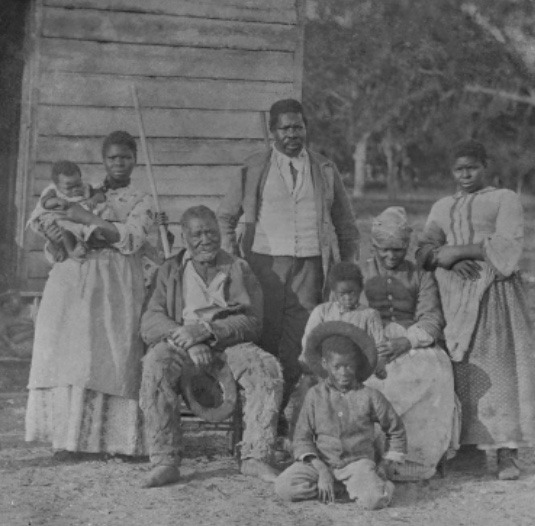

Don’t believe me? It’s all in this book by the expert on the subject, Larry Koger of the University of South Carolina. And he demolishes the idea that most blacks bought slaves only to get family members out of slavery. Like whites, some were kind masters and some were mean, but, for the most part, they owned slaves for exactly the same reasons whites did.

There’s a whole book about this black guy, Andrew Durnford.
He had a plantation of 672 acres along the Mississippi in Louisiana, and close to 100 slaves. Another black slave owner in Louisiana, P.C. Richards, owned 152 slaves. Black slaveowners avidly supported the Confederacy. There are no accurate estimates of the number of slaves held by free blacks at the time of the Civil War, but they would have been tens of thousands.
If slavery is somebody’s Original Sin, it’s sure not ours. Take a look at this map of the slave trade, beginning in 1500.

[Source: SlaveVoyages.com, click to enlarge]
The thicknesses of the lines represent numbers of slaves. What became the United States imported just around 400,000 slaves—about 3 percent of all the slaves who crossed the Atlantic. Look at all the slaves who went to Brazil and to the Caribbean Islands.They needed millions because, unlike American slaveowners who raised slave families, they bought grown men and worked them to death. And let us not forget, virtually every slave on this map was caught by blacks or Arabs.
And look at all the slaves who ended up in North Africa and the Middle East.
That’s millions of them going to Muslim countries at exactly the same time slaves were crossing the Atlantic. And Arabs had been taking black slaves out of Africa, across the Sahara, for 900 years before America was even discovered—and a forced march across the desert was a lot worse than crossing the Atlantic. In this article about Africa’s first slavers—the Arabs—historian Paul Lovejoy estimates that over the centuries, Muslims took about 14 million blacks out of Africa [Recalling Africa’s harrowing tale of its first slavers – The Arabs – as UK Slave Trade Abolition is commemorated, March 27, 2018]. That is more than the 12 million who went to the New World.
And you might ask, where are the descendants of all those Middle Eastern slaves? America has millions of slave descendants. Why don’t you see lots of blacks in Saudi Arabia or Syria or Iraq? Arabs castrated black slaves so they wouldn’t have descendants.

Muslims were even more enthusiastic about enslaving white people. Christian Slaves, Muslim Masters, by Prof. Robert C. Davis is the best book on the subject. Remember the Barbary Pirates of North Africa? Between 1530 and 1780 they caught and enslaved more than a million white, European Christians. During the 16th and 17th centuries, Arabs took more white slaves south across the Mediterranean than there were blacks shipped across the Atlantic.
Mostly, Muslim pirates captured European ships and stole their crews. In just three years, from 1606 to 1609, the British navy admitted it had lost 466 British merchant ships to North African pirates [Counting European Slaves on the Barbary Coast Past & Present, August 2001]. Four hundred sixty-six ships in just three years. Arabs took American slaves. Between 1785 and 1793 Algerians captured 13 American ships in the Mediterranean and enslaved the crews. This is a 1804 battle between Arab pirates and the USS Enterprise.

It was only in 1815, after two wars, that the United States was finally free of the Barbary pirates.
Muslim pirates also organized huge, amphibious slave-catching assaults that practically depopulated the Italian coast. In 1544, Algerian raiders took 7,000 slaves in the Bay of Naples in a single raid. This drove the price of slaves so low it was said you could “swap a Christian for an onion.”
After a 1566 raid on Granada in Spain netted 4,000 men women, and children, it was said to be “raining Christians in Algiers.” Women were easier to catch than men, and were prized as sex slaves, so some coastal areas lost their entire child-bearing populations. One raid as far away as Iceland brought back 400 white slaves.
Prof. Davis notes that the trade in black Africans was strictly business, but Muslims had a jihad-like enthusiasm for stealing Christians. It was revenge for the Crusades and for the reconquest of Spain from the Arabs in 1492. When Muslim corsairs raided Europe, they made a point of desecrating churches and stealing church bells. The metal was valuable but stealing church bells silenced the voice of Christianity.
It was a tradition to parade newly captured Europeans through the streets so people could jeer at them, while children threw garbage at them. At the slave market, both men and women were stripped naked to evaluate their sexual value. In the North African capitals—Tunis, Algiers, Tripoli—there was a big demand for homosexual sex-slaves. Other Europeans were worked to death on farms or building projects.
Prof. Davis writes that unlike in North America, there were no limits on cruelty: “There was no countervailing force to protect the slave from his master’s violence: no local anti-cruelty laws, no benign public opinion, and rarely any effective pressure from foreign states.” Slaves were not just property, they were infidels, and deserved whatever suffering a master meted out.
For a man, there was a fate even worse than being a sex slave. Hundreds of thousands became galley slaves, often on slave-catching pirate ships. They were chained to their oars 24 hours a day, and could move only to the hole where the oar went through the hull—so they could relieve themselves. If the men were rowing, they fouled themselves. Galley slaves lived in a horrible stench, ate rotten food, were whipped by slave drivers and tormented by rats and lice. They could not lie down and had to sleep at their oars. Many never left their ships, even in port. Their job was to row until they died, and to be tossed overboard at the first sign of weakness.
Muslims have taken slaves for as long as there have been Muslims, which is about 1,400 years.

Mohammed himself was an enthusiastic slave trader. Muslims still take black slaves. As this article points out, Libya still has slave markets, Mauritanian Arabs take black slaves, and there is still slavery in Niger, Mali, Chad and Sudan[Libya’s slave markets are a reminder that the exploitation of Africans never went away, by Martin Plaut, New Statesman, February 21, 2018].
And, of course, it was white people who abolished slavery, both in their own countries and, except for a few stubborn holdouts, the whole world. Africans, just like the Tlingit Indians, screamed about all the wealth we made them give up.
But slavery’s still our “original sin.” As Time magazine wrote just this month about slavery “Europeans and their colonial “descendants” in the United States engineered the most complete and enduring dehumanization of a people in history."[Facing America's History of Racism Requires Facing the Origins of 'Race' as a Concept, by Andrew Curran, July 10, 2020]
What a small minority of Americans did for 246 years—and in a relatively mild form—is worse than anything that was ever done anywhere by anyone.
That, ladies and gentlemen, is the power of white privilege. I hope you are enjoying it. Watch this video:
youtube
51 notes
·
View notes